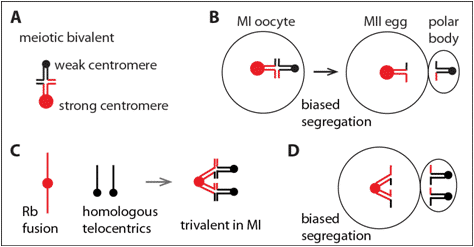Chromosomes “Cheat” Their Way into the Egg Cell Gamete Formation
At the core of Mendelian genetics is the concept that gametes are equally likely to carry either of the two parental copies of a gene. But, selfish genetic elements can cheat, however, by subverting Mendelian segregation to increase their representation in the gametes, say scientists at the University of Pennsylvania.

This basically means that chromosomes “cheat” to have a rate of making it into the functional ovum, as opposed to a polar body, which is much higher than chance would predict (a polar body is one of three smaller cells that buds off from an oocyte, a cell in the ovary which undergoes meiosis to form an ovum, at the oocyte’s two meiotic divisions and degrades as opposed to developing into an ovum). This process in which certain alleles are favorably transmitted to the gamete is known as “meiotic drive”.
With careful observation and experiments with mouse oocytes, the precursors of eggs, the researchers have detected molecular signals that create an asymmetry in the machinery that drives meiosis, the cell-division process that gives rise to gametes. Certain chromosomes, the researchers found, exploit this asymmetry to move over to the “right” side of a cell during division and wind up in the egg.
“If we understand how these selfish elements are exploiting the mechanics of meiosis, then we’ll understand more deeply how that process works in the first place,” said Michael Lampson, associate professor of biology in Penn’s School of Arts and Sciences and senior author on the study.
“Usually we think about selfish genes at the level of natural selection and selection of the fittest,” Lampson said. “That might mean a gene that makes you live longer or reproduce more or kill your enemies is more likely to be passed on. But we can also think about selfishness at the level of the gene itself. In that context, genes are competing with each other to get into the gamete. And while we had evidence that this could happen, we didn’t really understand how it did happen.”

The study involving mouse oocytes detected molecular signals which were shown to create an asymmetry in the machinery driving meiosis. To investigate the cause of this, the researchers focused on the meiotic spindle: the structure which pulls the pair of chromosomes apart to opposite poles of the cell by their centromere during anaphase I and later pulls the sister chromatids apart to opposite poles of the cell during anaphase II (anaphase I and II being staged during meiosis).
The team looked at microtubules, which the meiotic spindle consists of, and found a lower distribution of a modification called tyrosination in the egg side of the cell as opposed to the opposite side, the cortex. However, this asymmetry in the distribution of tyrosination was only present during the stage of meiosis when the spindle moves from the equator, the middle of the cell, towards the cortex. This, therefore, shows that the cortex is the origin of the signal which sets up the modification of tyrosine.
With this established the researchers then tested their hypothesis of whether a molecule called CDC42, Cell Division Control Protein 42 homolog, contributed to tyrosination being asymmetrical. Members of the team, Lampson, and Chenoweth, created an experimental system to test this by using a light-sensitive assay (an investigative procedure to determine the functional activity of CDC42) to selectively enrich CDC42 on one side of the pole (the signals shown as green in the diagram with the microtubule tyrosination in white). From this, they inferred that CDC42 was at least partly responsible for inducing the tyrosination asymmetry and so the spindle’s asymmetry in the dividing cell.
With the use of live imaging of mouse oocytes, they were able to discover that “stronger” centromeres were more likely to detach themselves from the spindle, especially when orientated to the cortical side of the cell, than the weaker ones which didn’t really seem to mind being in either side of the cell. They believe that the stronger ones do so in order flip themselves so that they are they are positioned to the pole of the cell which will later develop into the ovum ( see diagram) as “if you’re a selfish centromere and you’re facing the wrong way… that’s how you win”, as said by Lampson.
In future work, Lampson and his team hope to further explore what characteristics of the centromeres make them strong or weak.
“This work gave us some good information about biased transmission of centromeres, but it also brings up a ton of other questions,” Lampson said. “Why do our centromeres look the way they do, and how do they evolve to win these competitions? These are fundamental biological questions that we still don’t know a lot about.“






























